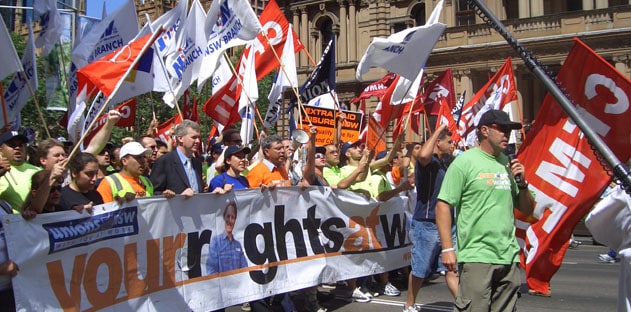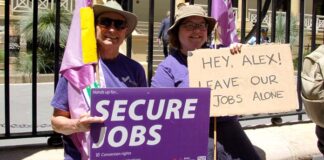James Supple looks at the lessons from the union campaign that defeated Liberal Prime Minister John Howard in 2007
The Your Rights at Work campaign was key to toppling the Howard Liberal government in 2007. As an unpopular Tony Abbott gears up to cut public services and welfare, there are important lessons for planning the fightback this time around.
Your Rights at Work is sometimes reduced to the TV advertising campaign. There is no doubt the ads struck a chord. But it was the mass demonstrations and strikes that were crucial to shifting opinion against WorkChoices and kicking out John Howard in 2007.
When Howard won re-election in October 2004, with control of the Senate for the first time, it was immediately clear that unions would face a major attack. Howard had already made several attempts to re-write industrial relations laws since 1996, but after the Workplace Relations Act, much of his more draconian agenda had been blocked in the Senate.
Initially senior union leaders showed no intention of trying to fight Howard’s new offensive. Following an emergency meeting after the 2004 election, ACTU President Sharon Burrow meekly declared, “At this point in time, we don’t have any plans to actually respond to the Prime Minister’s agenda with industrial activity.”
Instead the unions would try to work around the new laws. They planned to “box clever” and protect themselves, by negotiating new three-year wage deals before the laws took effect in the hope Labor would win the next election.
But as discussion developed in the unions, and the scale of Howard’s attack became clear, this outlook started to shift. The left officials in Victoria, where the left unions controlled the Trades Hall Council, were the first to support a mass campaign against the laws. By early 2005, construction union secretary Martin Kingham and others were arguing to fight the laws, saying the union leadership had a responsibility to encourage resistance.
The campaign began with a mass all-union delegates’ meeting in Melbourne in March, bringing together hundreds of union delegates.
The size of the meeting and union members’ enthusiasm surprised union officials, and in turn, generated pressure for further action. Buoyed by the Victorian success, delegates meetings followed in NSW in May and WA in June.
Strike action
The Melbourne meeting voted for a mass stopwork rally against the laws on 30 June. Again, this pressured the union councils in NSW and Queensland to call similar protest action.
There was an argument within the union movement about whether industrial action and mass protests were necessary at all. The ACTU continued to oppose mass stop work rallies outside Victoria. ACTU Secretary Greg Combet justified this by saying, “We should stop bullshitting ourselves that we can stop this legislation.” Instead they remained focused on waiting for the next election and the hope of a Labor victory. In September Cath Bowtell from the ACTU was still trying to hose down action arguing, “We can’t be stupid and afford copping fines,” and that “we need to look to the next election or two.”
At delegates’ meetings in NSW in early 2005, then Unions NSW Secretary John Robertson argued that any state-wide or national stopwork would play into the government’s hands, would be small, and would alienate public support. Instead the ACTU preferred to throw millions of dollars at the TV advertising campaign.
Despite the ACTU’s conservatism, in Melbourne on 30 June 2005 150,000 workers joined the stopwork march. Elsewhere, with less organised industrial action to walk off the job, the rallies were smaller. But still 20,000 marched in Sydney.
Strike action to attend rallies was already illegal—unions and workers were defying the law to protest.
The next day of action in November saw the bosses of the Australian Building and Construction Commission threaten workers with individual $22,000 fines for staging illegal industrial action to take part. To no avail—up to 500,000 took action nation-wide. Efforts by Ford, Holden, Toyota, Qantas, Visy and BOC Gases in Victoria to intimidate their workers from walking out all failed.
In Melbourne, Socialist Worker reported, “About 100 schools closed, with a massive teacher presence on the march. Postal workers stopped in larger numbers than on the last mass rally, despite Australia Post disciplining strikers who joined the June 30 protest.
“All three car plants stopped work, with the manufacturing workers’ union having trouble booking enough buses to bring members to the rally. Centrelink workers at three offices—Moreland, Yarra and Darebin—walked out in a brilliant act of defiance against the federal government.”
The strike action also pointed to a strategy for actually stopping Howard even passing WorkChoices into law. In Melbourne the first rally had cost bosses $20 million. An ongoing strike campaign would have hit the bosses where it hurts, crippling their profits.
Even with their control of the Senate, the Liberals would not have been able to hold out for long the face of determined strike action, and employers losing hundreds of millions of dollars. But the campaign was a long way from considering such political strike action.
Nonetheless, the way the campaign developed shows two things. Firstly, that the union officials’ position as negotiators of labour makes them inclined to be conservative, and they will look to avoid a serious fight if they can. But it also shows the possibility of building up pressure from the rank and file within the unions to encourage and push union leaders into calling protests and strikes.
Motions moved across local union branches pressured union leaderships to call action. And successful meetings, protests and strikes generated pressure on other unions to call action too, by showing how it was possible to resist. Demonstrations that begin outside the union movement—like those against Abbott’s threats to Medicare or March in March—can also have the effect of encouraging industrial resistance.
Electoral focus
The ACTU only ever saw the demonstrations as part of a push to elect a Labor government. After WorkChoices became law at the end of 2005, they directed the campaign into an electoral strategy. In November 2006, a new slogan was unveiled, with stark symbolism: “Your Rights at Work—worth fighting for” became “Your Rights at Work—worth voting for”.
In the run-up to the 2007 election, the ACTU focused on organising local Rights at Work groups based in marginal electorates, to get the vote out for Labor.
WorkChoices was the key issue that finished Howard off at the election. Essential Media polling during the election campaign recorded that 88 per cent of those who identified themselves as shifting towards Labor said WorkChoices was the main reason. In the 2007 Australian Election Study 67 per cent of people said industrial relations had been “extremely important” in deciding how to vote, and it ranked equal first out of 11 issues of importance.
The union delegates meetings and mass demonstrations had been decisive in making WorkChoices the focus of anti-Howard feeling at the election. The mass meetings mobilised key union activists across all the major unions, and armed them with arguments to take back to their workplaces.
Newspoll results showed that the number of people who rated industrial relations as “very important” to how they would vote went from 31 per cent before the campaign started to 49 per cent by early October 2005. Already by August 2005, 64 per cent of people interviewed in marginal seats thought WorkChoices would be “bad for the average worker”.
The ACTU’s TV advertising had an impact too. The first TV ad was launched two weeks before the June 2005 protest. But a short TV commercial can perhaps draw attention to an issue. Consolidating opposition to WorkChoices required a deeper knowledge of the changes and discussions about the need for action. For this, the conversations that thousands of union members and delegates had at a workplace and community level were crucial. Opinion polls showed that the more people knew about WorkChoices, the less they liked it.
Stopping short
The union campaign succeeded in driving Howard from power. But it failed to get WorkChoices scrapped. Labor kept the bulk of WorkChoices when it took government, retaining requirements for secret ballots to hold industrial action, a ban on pattern bargaining and a ban on strike action outside of prescribed bargaining periods.
The consequence of collapsing the campaign into electoral local groups campaigning in marginal seats was that there was little focus on building in the workplace, where unions’ industrial power is based.
Ironically, despite making WorkChoices a decisive issue of the election, the unions failed to build their fighting strength through the campaign. Total union membership actually fell by 5 per cent, or 89,000, in the year to August 2007 when the campaign was at its height.
Most of the local Rights at Work groups were shut down following the 2007 election. With Labor in government, a marginal seats campaign made no sense at all.
Without waging an industrial campaign using strikes and mass protests to fight the bosses and pressure Labor after it won government, the unions were not going to win fair work laws. But it was this very strategy of using their industrial power that they been rejected in the Your Rights At Work fight against Howard.
The lessons for fighting Abbott are clear. The unions still retain immense potential power to fight for change. Despite their membership decline, there are still 1.8 million union members. They still enjoy wide support and many more workers would join if they had the chance.
Their strongest weapons are mass protests and strike action—with the capacity to mobilise hundreds of thousands across the country. Any successful campaign against Abbott’s cuts would need to centre on mass stop work action. And, following the disaster of WorkChoices-lite and the Rudd and Gillard Labor governments, the campaign shouldn’t put its trust in Labor to deliver change.
It is industrial power that holds the key to fighting Abbott, and fighting the system. We will need to fight a future Labor government just as hard.






